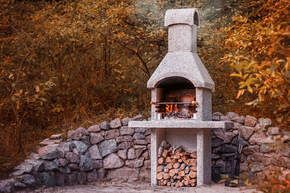Explore the art of brick oven cooking! From intense heat to smoky flavor, learn why brick ovens make every meal special and delicious. A brick oven is an excellent piece of masonry to add to your home. It creates a certain flair that is both elegant and useful. It is possible to cook a wide range of foods in a brick oven using various techniques.
Here are some general pointers:
1. Whenever possible, you should preheat your wood-fired oven fully, but do not move the fire or coals to the side. Next, let the temperature in the oven decrease to the appropriate range for your cooking style.
2. You could fire your pizza oven for longer if you’re going to be cooking for a large party, or baking several loaves of bread, or roasting a large amount of meat. Make sure that you only fire your brick oven for a short amount of time — usually, until the top turns white.
Ways To Cook In A Brick Oven
Cooking over fire
In this cooking style, the goal is to completely fill the floor and the dome of your brick oven masonry with heat, build up a large bed of coals and maintain an enormous flame, where it reaches up to the dome.
When a pizza oven is ready to bake pizza, check if it has a clear and soot-free dome. Then, turn off the fire, and keep a large fire going. The flame should reach the center of the brick oven.
The pizza oven should be at 650F-700F. Keep the door open and add wood every 15-20 minutes to maintain a large flame.

Roasting
At temperatures ranging from 450F to 600F, roasting meats, browning vegetables, and cooking casseroles are a perfect thing to do in your masonry oven.
This temperature range works well for thoroughly cooking food evenly and not burning. This temperature range is lower than for fire-in-the-oven baking but higher than regular baking that you would do in your standard oven.
The oven when fully fired, combined with a low fire, allows you to seal and brown dishes. Then continue cooking the dish for a more extended period of time as the temperature gradually drops.
This process requires a medium bed of coals, a few inches high flame, and no black on the dome. For roasting times under one hour, the oven door may be left off or positioned inside the oven’s arch opening to regulate the temperature. You can add small pieces of wood as needed to maintain the required temperature.
Baking
Baking uses conventional oven temperatures to bake bread, desserts, vegetables, legumes, and pasta dishes. This process is typically below 500F.
Once your oven is fully fired, carefully rake the hot coals out, then scrub the oven deck with a damp towel. This allows your oven to cook smoothly and uniformly as the temperature falls despite not being properly ventilated.
With this method, you can either bake one full-load batch of bread or various batches of a variety of bread at a time. Keep the door closed tightly against the opening of the masonry to retain heat and steam.
Grilling
Your brick oven can be a great grill. You can enjoy a grilling style that sets seared grill marks and seals in moisture — creating food that is both crisp and moist.
With heat from the grill itself, produced by the coals, the brick oven makes a great BBQ. You can also experiment with various pots and pans. A preheated cast iron grill pan produces excellent sear marks; terracotta and steel pans impart a different texture and flavor to potatoes.
A qualified mason is experienced and knowledgeable when building a brick oven. Avoid safety and structural problems by hiring a professional





